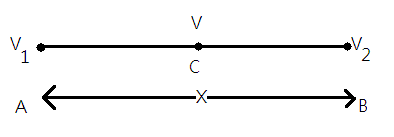
A particle moving with uniform acceleration from A to B along a straight line has velocities ${v_1}$ and ${v_2}$ at A and B, respectively. If C is the mid-point between A and B, then determine the velocity of the particle at C.

A) $v = \sqrt {\dfrac{{{v_1}^2 + {v_2}^2}}{3}} $
B) $v = \sqrt {\dfrac{{{v_1}^2 + {v_2}^2}}{2}} $
C) $v = \sqrt {\dfrac{{{v_1}^2 + {v_2}^2}}{4}} $
D) $v = \sqrt {\dfrac{{{v_1}^2 + {v_2}^2}}{{8}}} $
Answer
216.6k+ views
Hint: In this problem, it is given that a particle travels from a point A to point B with uniform acceleration. We are required to find the velocity of the particle at mid-point of the journey. Apply the kinematical equation from point A to C and then from point C to B. The distance travelled is the same in both cases. Equating both the equations, we can find the velocity at the midpoint.
Complete step by step solution:
Let us consider the total distance between A and B is $x$ units. As, C is the midpoint of AB thus, the distance $AC = CB = \dfrac{x}{2}$. We are given with the initial velocity at A to be ${v_1}$ and let the acceleration of the particle be $'a'\,m{s^{ - 2}}$.
Let the velocity at point C will be $v$ , from kinematical equation we have:
${v^2} - {v_1}^2 = 2a\dfrac{x}{2}$
$ \Rightarrow {v^2} - {v_1}^2 = ax$--equation $1$
Also, we are given with the final velocity at B to be ${v_2}$ and the acceleration of the particle remains constant, $'a'\,m{s^{ - 2}}$
The displacement is $\dfrac{x}{2}$
For motion between point C and D, the initial velocity of the particle is the velocity at point C, $v$ :
Applying kinematical equation between point C, we have
${v_2}^2 - {v^2} = 2a\dfrac{x}{2}$
$ \Rightarrow {v_2}^2 - {v^2} = ax$--equation $2$
From equation $1$ and equation $2$ , we have
${v^2} - {v_1}^2 = {v_2}^2 - {v^2}$
$ \Rightarrow {v^2} + {v^2} = {v_2}^2 + {v_1}^2$
$ \Rightarrow 2{v^2} = {v_2}^2 + {v_1}^2$
$ \Rightarrow {v^2} = \dfrac{{{v_2}^2 + {v_1}^2}}{2}$
$ \Rightarrow v = \sqrt {\dfrac{{{v_2}^2 + {v_1}^2}}{2}} $
This is the velocity of the particle at point C.
Thus, option B is the correct option.
Note: The velocity at C is not the average of the initial and final velocity as the particle is having a constant acceleration thus, its velocity is constantly changing. While applying the kinematical equation between C and B, the initial velocity is the velocity at point C and the final velocity is the velocity at point B.
Complete step by step solution:
Let us consider the total distance between A and B is $x$ units. As, C is the midpoint of AB thus, the distance $AC = CB = \dfrac{x}{2}$. We are given with the initial velocity at A to be ${v_1}$ and let the acceleration of the particle be $'a'\,m{s^{ - 2}}$.
Let the velocity at point C will be $v$ , from kinematical equation we have:
${v^2} - {v_1}^2 = 2a\dfrac{x}{2}$
$ \Rightarrow {v^2} - {v_1}^2 = ax$--equation $1$
Also, we are given with the final velocity at B to be ${v_2}$ and the acceleration of the particle remains constant, $'a'\,m{s^{ - 2}}$
The displacement is $\dfrac{x}{2}$
For motion between point C and D, the initial velocity of the particle is the velocity at point C, $v$ :
Applying kinematical equation between point C, we have
${v_2}^2 - {v^2} = 2a\dfrac{x}{2}$
$ \Rightarrow {v_2}^2 - {v^2} = ax$--equation $2$
From equation $1$ and equation $2$ , we have
${v^2} - {v_1}^2 = {v_2}^2 - {v^2}$
$ \Rightarrow {v^2} + {v^2} = {v_2}^2 + {v_1}^2$
$ \Rightarrow 2{v^2} = {v_2}^2 + {v_1}^2$
$ \Rightarrow {v^2} = \dfrac{{{v_2}^2 + {v_1}^2}}{2}$
$ \Rightarrow v = \sqrt {\dfrac{{{v_2}^2 + {v_1}^2}}{2}} $
This is the velocity of the particle at point C.
Thus, option B is the correct option.
Note: The velocity at C is not the average of the initial and final velocity as the particle is having a constant acceleration thus, its velocity is constantly changing. While applying the kinematical equation between C and B, the initial velocity is the velocity at point C and the final velocity is the velocity at point B.
Recently Updated Pages
JEE Atomic Structure and Chemical Bonding important Concepts and Tips

JEE Amino Acids and Peptides Important Concepts and Tips for Exam Preparation

Electricity and Magnetism Explained: Key Concepts & Applications

Chemical Properties of Hydrogen - Important Concepts for JEE Exam Preparation

JEE Energetics Important Concepts and Tips for Exam Preparation

JEE Isolation, Preparation and Properties of Non-metals Important Concepts and Tips for Exam Preparation

Trending doubts
JEE Main 2026: Application Form Open, Exam Dates, Syllabus, Eligibility & Question Papers

Derivation of Equation of Trajectory Explained for Students

Hybridisation in Chemistry – Concept, Types & Applications

Understanding the Angle of Deviation in a Prism

Understanding Collisions: Types and Examples for Students

How to Convert a Galvanometer into an Ammeter or Voltmeter

Other Pages
JEE Advanced Marks vs Ranks 2025: Understanding Category-wise Qualifying Marks and Previous Year Cut-offs

Units And Measurements Class 11 Physics Chapter 1 CBSE Notes - 2025-26

NCERT Solutions For Class 11 Physics Chapter 8 Mechanical Properties Of Solids

Motion in a Straight Line Class 11 Physics Chapter 2 CBSE Notes - 2025-26

NCERT Solutions for Class 11 Physics Chapter 7 Gravitation 2025-26

Understanding Atomic Structure for Beginners




